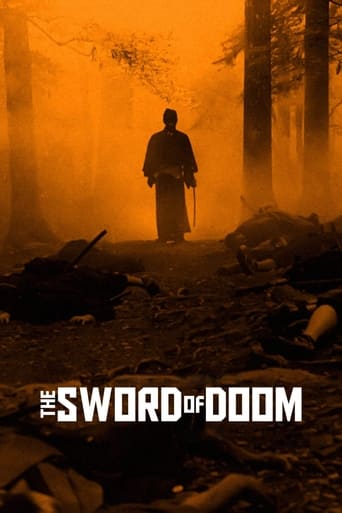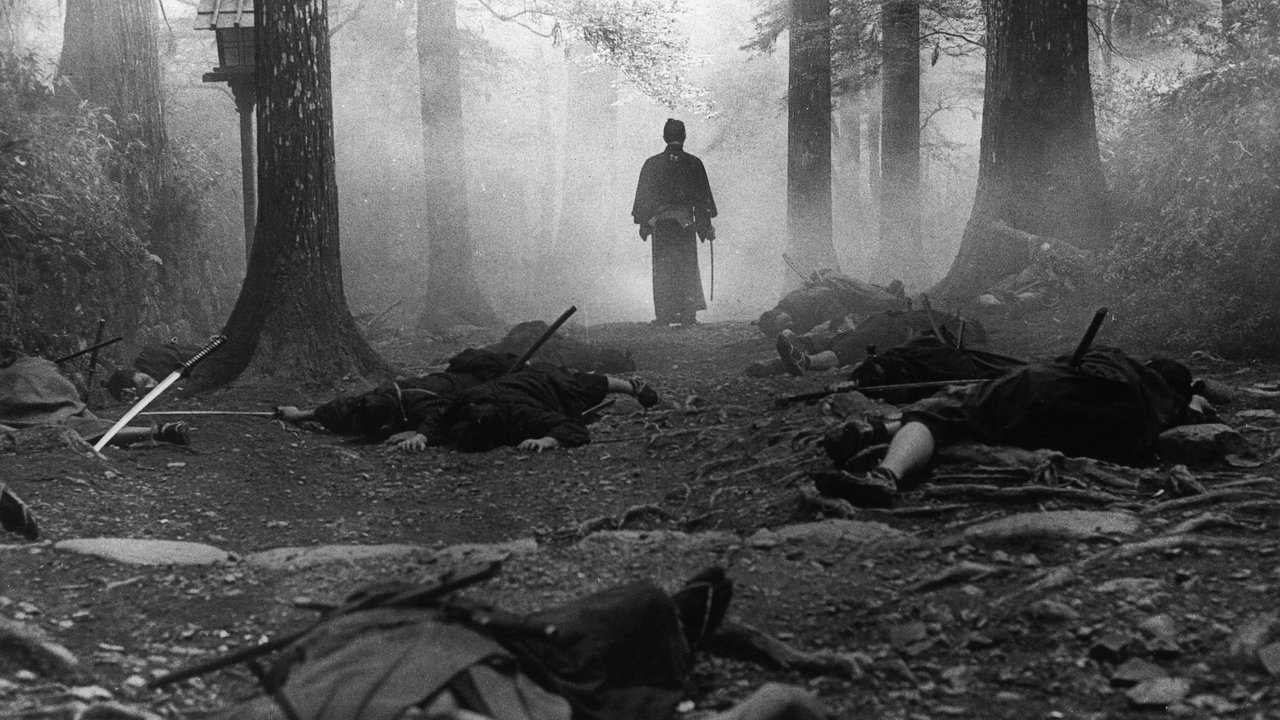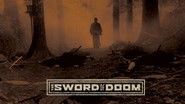Smallclone100
This is an epic film. Everything from the sound editing to the acting, the fight scenes and the way it looks is mesmerizing. There's a scene at the beginnign where the grinding of the water mill sounds like the beating of a woman's heart just before she is brutally attacked, which is followed up by a more suggestive motion of the mill's inner workings. Metaphors like that help create the tension which is cranked up throughout. I couldn't help thinking while watching it, that this movie must have been a massive influence to modern day film-makers like Quentin Tarantino. The most noticeable thing though is the lighting. It's used to great effect in most scenes to project shadows and silhouettes.If I had to criticise it, I would say the ending is slightly abrupt, but that's being a bit harsh. Overall it's a highly stylish, brutal tale of a samurai on the path to self destruction
Hereticked
An old man kneels to pray on the mountaintop trail of his pilgrimage. He pleads to Buddha for death so that he will no longer be a burden to his granddaughter. Appearing from a pure white cloud, seeming to step out of the sky itself, Ryunosuke arrives, dressed in pure black, ready to carry out the old man's wish. Is he just a wandering samurai? Is he the angel of death? Or is he, as the original title "Dai-bosatsu tôge" (The Great Bodhisattva Pass) might suggest, a "Danava": a dark Asura from Buddhist mythology. This question is never answered directly and The Sword of Doom is a much better film for it. The mystery of Ryunosuke is far more compelling than any answer to his origin and purpose could possibly be.From the opening scenes it's established that, mortal or not, Ryunosuke is an empty vessel with no compassion. His father, in their only encounter in the film, tells him to his face that he's cruel and disturbed. Ryunosuke agrees to an act of mercy on behalf of a fellow student only if the student's wife will sleep with him. Ryunosuke seems to approach the world with relentless selfishness and single minded ferocity, finding fulfillment only in conquest and death. He is, to put it mildly, a sociopath, which puts him at odds with the whole of Japanese society, a people culturally fixated on morals, shared responsibility, sacrifice and putting others first.But who's to say that a sociopath can't be a great samurai? Like European chivalry, the code of Bushido had much to say about social ritual and character development, but in the end they were doctrines engaged in the futile attempt to make war, to some extent, "civil." What if a man with no scruples and nothing at his core but a thirst for violence was to cast aside the moral platitudes of that system but still play, in a technical sense, by its rules? Would the world be a better place? Or would it be much worse?The key to understanding Ryunosuke and the themes of The Sword of Doom lies, I believe, in a scene that takes place in the middle of the film. Having rented his skills out to the Shinsengumi (a secret force employed by the Shogunate), Ryunosuke and his party ambush a government official on a snowy winter night. They descend on their target only to discover that it's the wrong man. Rather than the political figure they were after, out steps Toranosuke Shimada, one of the greatest swordsmen in all of Japan. All but Ryunosuke attack him and Shimada cuts down their entire party in short order, leaving dozens of bodies strewn in the bloody snow. Ryunosuke watches in awe, but does not act. Shimada, sensing that he's no threat, sheathes his sword and speaks cryptically to Ryunosuke about good and evil.Why?!? Until this point Ryunosuke has never shown a hint of hesitation. Most seem to attribute his actions to fear, but that's unlikely. We know he's a sociopath, we've already seen his supernatural skill, we're keenly aware that he finds an almost orgasmic bliss in violent confrontation and as a committed samurai, he's not afraid to die. This is not typical fear, this encounter has disturbed him on a much deeper level. So why doesn't he attack? The answer is simple: he can't. "Honor" forbids it.Not only is he the wrong target, but Shimada never attacks him and so Ryunosuke can't respond. It should also be noted that Ryunosuke's cruel style of combat relies on baiting his opponents into striking first which he can read/sense with uncanny efficiency and counter-attack for a kill. But now he's met a virtuous samurai who won't be baited. Shimada is an "Aditya" (benevolent Asura) to his "Danava" and Ryunosuke is shaken for the first time.If you study the film and review each violent incident that Ryunosuke is party to, you will notice one critical similarity. At no point does Ryunosuke ever violate Bushido:1. Old man on the mountain prays to Buddha for death (mercy kill)
2. Official match vs Bunnojo (Bunnojo threatens his life with an illegal move, Ryunosuke kills him in defense)
3. Mountain ambush (self defense)
4. Assassination of clan official (Ryunosuke waits for the official to attack first, then kills him)
5. Assassination #2: (Shimada never threatens him so Ryunosuke doesn't act)
6. Killing his mistress (Hama attempts to murder him in his sleep, self defense)
7. Clan massacre/final scene (self defense)Since Ryunosuke is an utter sociopath he has no way to internalize the morality that Bushido attempts to impart to its adherents, but nevertheless uses it as a system to govern his actions. He's someone who follows the rules of honorable conduct in combat while completely ignoring the spirit of Bushido. You could say he's the ultimate "lawful evil" character.And yet, if we strip away Ryunosuke's sinister personality and simply compare his actions to the vast majority of samurai throughout history, are they really so different? It's in this frame that The Sword of Doom can be viewed as a criticism of Bushido and a dissection of the moral failings of Japan's (often glorified) samurai caste. Indeed, perhaps all samurai hold "the sword of doom" in their hands, no matter what philosophy they may incorporate to justify their actions. Ryunosuke is simply the most pure distillation of that reality laying bare the ugly truth.Since this is a review in addition to an analysis, I want to focus on the aesthetics of the film for a bit. The Sword of Doom is one of the most beautiful films I've ever laid eyes on. The sets are immaculately conceived, the camera angles are diverse and the shots amazingly composed. It's use of black and white is so stunning that I wouldn't even want to see it in color.The script is tight and, with the exception of a few historical footnotes, narrowly focused on moving the plot forward. The characters are well defined and even the minor ones impart meaningful dialogue. Tatsuya Nakadai portrays a brooding nihilist more skillfully than anyone I can think of and the movie is full of good performances from its supporting cast as well.There are many period pieces where the action contains cartoonishly extended clashes between two characters, but The Sword of Doom's action set pieces are conducted smoothly with a dead seriousness that's only too appropriate for the movie's tone. Every face-off between two characters is over in moments, much like it would be in real life.Most notably, the sound in The Sword of Doom is incredible. It uses music only when appropriate and its use of sound effects stands out in the best possible way. There are several moments where the sound from one scene bleeds into the next, creating haunting transitions that give the film an ethereal quality.From the nonstop pounding of a water mill's hammer alluding to the illicit sex happening just off screen to the dizzying use of light and shadow in the lead-up to the grand finale, The Sword of Doom is also full of skillful visual tricks and metaphors. I've seen the film a dozen times and still feel like I've yet to discover all that's hidden in the depths of its images.In the final scene Ryunosuke's past has caught up to him. His previous victims assail him psychically. He is trapped in a hall of shadows and assaulted on all sides by an endless stream of samurai as fire begins to rage around him. It's hard not to see this as symbolic of hell and yet his maniacal laughter informs us that he welcomes the chaos. Ryunosuke is trapped in an endless cycle of violence. "Honor" will not lead him out of it. Bushido cannot give him the basic humanity required to cultivate the virtues it prescribes. It can only justify his killing.It's a shame we'll never get to see the next two films (The Sword of Doom was meant to be part one of a trilogy), but in a way I'm glad it ended where it did. There's no guarantee that subsequent entries would have been as good or that Ryunosuke's evolution would have been as interesting as the character study we're given. The Sword of Doom stands as a dark masterpiece and, in my opinion, the ultimate samurai film.
WILLIAM FLANIGAN
Viewed on DVD. Editing /continuity = four (4) stars; choreography = three (3) stars; . Director 's Kihachi Okamoto's melodramatic, confusing mash up depicting mid 19th Century Samurai life and times. Most actors and actresses are made up to look too much alike (name tags would really help!) and inter-scene continuity is often nonexistent (what is plotted in a scene may never be executed in later ones). The Director appears to have employed EVERY available Samurai stuntman in Kyoto (and a number of semi-pros to boot!) who keep reappearing and dying over and over again. Lead actor (Tatsuya Nakadai) plays your standard-issue Samurai sociopath whose character alternates between brooding and slashing. (Toshiro Mifune makes a light-weight cameo appearance.) Slashing scenes (including a prolonged attack on bamboo curtains (cheap props apparently substituting for mirrors?) by the lead protagonist) are way too long and, ultimately, become comic (intentional?) and boring. Choreography needs some work. Stuntmen in scenes of 20 (or more) sword swingers are often shown slashed and dying without being touched by a sword (a sword is just waived in their general direction!). Cinematography (wide screen, black and white) and scene lighting are fine. Same for sound, score, and subtitles. Skip this one unless you are seriously suffering from insomnia. WILLIAM FLANIGAN, PhD.
frankenbenz
Over the last thirty plus years hyper-violent action films have been on auto-pilot, recycling the same basic formula where one man with a special skill takes on an army of bad guys in some justified and cathartic slaughter. The motivation for these slaughters almost always involves some variant of a wrong doing typically in the form of the abduction or murder of the protagonist's wife and/or kids. 1967's The Sword of Doom might be party responsible for influencing this tired formula, but Kihachi Okamoto's samurai spectacle is as guilty of cashing in on a pre-existing formula as are its American predecessors. While SOD was made at the height of the Zatoichi craze, the Zatoichi franchise would not exist if not for the WW2- era Japanese Samurai films of Kenji Mizoguchi and Akira Kurosawa (to name a few). Considering the summer blockbuster phenomena was started by a movie ripped from the pages of Kurosawa's The Hidden Fortress, then it's pretty safe to say Hollywood owes Japan, at the very least, its respectful props. But if you consider that post-Kabuki Japanese cinema was greatly inspired by Hollywood, then you're stuck studying a convoluted timeline where influences are consumed by the influenced. What's the point of pointing out this self- consuming timeline? Perhaps the realization there is no such thing as an original story in cinema, just original ways of re-telling the same stories. In other words...it's all in the details.As far as details go, SOD proves even throwaway exploitation films can be incredibly rich, where every element of the mise-en-scène trumpet expert craftsmanship and a commitment to exceptional detail. The most striking of these elements are the images photographed by cinematographer Hiroshi Murai. Murai's work utilizes the very literal expression of black and white photography, painting the contrast between good and evil with the competitive opposition of darkness and light:In addition to the beautifully stark visuals, SOD distances itself from its many American clones thanks to the un-redemptive nastiness of protagonist Ryunosuke Tsukue (Tatsuya Nakadai). Commercial action films with this type of main character rarely (if ever) get financed and the reasoning is simple: how can an audience be expected to root for such a venomous tyrant? By the time SOD comes to a brutal and surprisingly abrupt close, little sympathy is spared for Ryunosuke and even though we know he's possibly the greatest swordsman in all of Japan, few tears are wept in his honor.



 AD
AD




